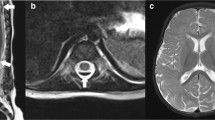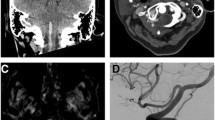Abstract
Takotsubo syndrome (TTS) can develop after intense physical or emotional stress and is uncommon in children. We report a 2-year-old girl who developed TTS caused by acute hydrocephalus after posterior fossa tumor resection and required mechanical ventilation and administration of vasopressor/inotropic agents. Her cardiac function gradually recovered over the course of 2 weeks. Hydrocephalus after posterior fossa surgery can cause compression of the medulla oblongata, resulting in solitary nucleus dysfunction and TTS, a potentially life-threatening complication.



Similar content being viewed by others
References
Akashi YJ, Nakazawa K, Sakakibara M, Miyake F, Koike H, Sasaka K (2003 Aug) The clinical features of takotsubo cardiomyopathy. QJM. 96(8):563–573. https://doi.org/10.1093/qjmed/hcg096
Berganzo K, Ciordia R, Gómez-Esteban JC, Tijero B, Agundez M, Velasco F, Valle MA, Zarranz JJ (2011) Tako-tsubo cardiomyopathy in a patient with bilateral lesions in the dorsal medulla. Clin Auton Res 21(1):65–67. https://doi.org/10.1007/s10286-010-0088-0
Crevier-Sorbo G, Atkinson J, Di Genova T, Puligandla P, Dudley RWR (2019 Apr 19) Hydrocephalus-induced neurogenic stunned myocardium and cardiac arrest in a child: completely reversed with CSF diversion. J Neurosurg Pediatr 24(1):35–40. https://doi.org/10.3171/2019.2.PEDS18711
Divekar A, Shah S, Joshi C (2006 May-Jun) Neurogenic stunned myocardium and transient severe tricuspid regurgitation in a child following nonaccidental head trauma. Pediatr Cardiol 27(3):376–377. https://doi.org/10.1007/s00246-005-1263-2
Drayer M, Geracht J, Madikians A, Harrison R (2006 Jul) Neurogenic stunned myocardium: an unusual postoperative complication. Pediatr Crit Care Med 7(4):374–376. https://doi.org/10.1097/01.PCC.0000225370.67241.AE
Finsterer J, Wahbi K (2014) CNS disease triggering Takotsubo stress cardiomyopathy. Int J Cardiol 177(2):322–329. https://doi.org/10.1016/j.ijcard.2014.08.101
Fishman RA (1992) Cerebrospinal fluid in diseases of the nervous system. Saunders, Philadelphia
Gekka M, Yamaguchi S, Kazumata K, Kobayashi H, Motegi H, Terasaka S, Houkin K (2014) Hemorrhagic onset of hemangioblastoma located in the dorsal medulla oblongata presenting with tako-tsubo cardiomyopathy and neurogenic pulmonary edema: a case report. Case Rep Neurol 6(1):68–73. https://doi.org/10.1159/000361041
Gobeske KT, Sarano ME, Fugate JE, Wijdicks EF (2018 Dec) Medulla oblongata hemorrhage and reverse takotsubo cardiomyopathy. Neurocrit Care 29(3):508–511. https://doi.org/10.1007/s12028-017-0482-8
Jarquin-Valdivia AA, Rich AT, Yarbrough JL, Thompson RC (2005 Aug) Intraventricular colloid cyst, hydrocephalus and neurogenic stunned myocardium. Clin Neurol Neurosurg 107(5):361–365. https://doi.org/10.1016/j.clineuro.2004.09.012
Johnson J, Ragheb J, Garg R, Patten W, Sandberg DI, Bhatia S (2010) Neurogenic stunned myocardium after acute hydrocephalus. J Neurosurg Pediatr 5(5):428–433. https://doi.org/10.3171/2009.11.PEDS09341
Kono T, Morita H, Kuroiwa T, Onaka H, Takatsuka H, Fujiwara A (1994 Sep) Left ventricular wall motion abnormalities in patients with subarachnoid hemorrhage: neurogenic stunned myocardium. J Am Coll Cardiol 24(3):636–640. https://doi.org/10.1016/0735-1097(94)90008-6
Levy R, Hader WJ (2011 May) Neurogenic stunned myocardium with ventriculoperitoneal shunt malfunction. Can J Neurol Sci 38(3):518–521. https://doi.org/10.1017/s0317167100011987
Liu S, Dhamee MS (2010 Feb) Perioperative transient left ventricular apical ballooning syndrome: Takotsubo cardiomyopathy: a review. J Clin Anesth 22(1):64–70. https://doi.org/10.1016/j.jclinane.2009.03.010
Lopez Chiriboga AS, Yoon JW, Freeman WD, Odunukan OW, Cheshire WP Jr (2016) Takotsubo cardiomyopathy in the setting of acute hydrocephalus secondary to neurocysticercosis. Clin Auton Res 26(3):235–241. https://doi.org/10.1007/s10286-016-0348-8
Ranieri M, Finsterer J, Bedini G, Parati EA, Bersano A (2018 Mar 22) Takotsubo syndrome: clinical features, pathogenesis, treatment, and relationship with cerebrovascular diseases. Curr Neurol Neurosci Rep 18(5):20. https://doi.org/10.1007/s11910-018-0833-7
Sato K, Masuda T, Kikuno T, Kobayashi A, Ikeda Y, Ohwada T, Kikawada R (1990) Left ventricular asynergy and myocardial necrosis accompa- nied by subarachnoid hemorrhage: contribution ofneurogenic pul- monary edema. J Cardiol 20:359–367
Tsuchihashi K, Ueshima K, Uchida T, Oh-mura N, Kimura K, Owa M, Yoshiyama M, Miyazaki S, Haze K, Ogawa H, Honda T, Hase M, Kai R, Morii I (2001 Jul) Angina pectoris-myocardial infarction investigations in Japan. Transient left ventricular apical ballooning without coronary artery stenosis: a novel heart syndrome mimicking acute myocardial infarction. Angina Pectoris-Myocardial Infarction Investigations in Japan. J Am Coll Cardiol 38(1):11–18. https://doi.org/10.1016/s0735-1097(01)01316-x
Vidi V, Rajesh V, Singh PP, Mukherjee JT, Lago RM, Venesy DM, Waxman S, Pyne CT, Piemonte TC, Gossman DE, Nesto RW (2009 Aug 15) Clinical characteristics of tako-tsubo cardiomyopathy. Am J Cardiol 104(4):578–582. https://doi.org/10.1016/j.amjcard.2009.04.028
Wittekind SG, Yanay O, Johnson EM, Gibbons EF (2014) Two pediatric cases of variant neurogenic stress cardiomyopathy after intracranial hemorrhage. Pediatrics. 134(4):e1211–e1217. https://doi.org/10.1542/peds.2013-1881
Acknowledgments
We thank Edanz Group (https://en-author-services.edanz.com/ac) for editing a draft of this manuscript.
Availability of data and material
N/A
Code availability
N/A
Author information
Authors and Affiliations
Contributions
Dr. Koyama was the major contributor in writing the manuscript. Dr. Koyama and Dr. Akutsu contributed to the diagnosis and treatment of the patient. Dr. Kawamura made critical revision of the manuscript. All authors read and approved the final manuscript.
Corresponding author
Ethics declarations
Ethics approval
All procedures performed in this case report were in accordance with ethical standards of the institution and with the 1964 Helsinki declaration.
Consent to participate
Informed consent for participation was obtained from the patient’s parents.
Consent for publication
Informed consent for publication was obtained from the patient’s parents.
Conflict of interest
The authors declare that they have no conflict of interest.
Additional information
Publisher’s note
Springer Nature remains neutral with regard to jurisdictional claims in published maps and institutional affiliations.
Supporting Information
Rights and permissions
About this article
Cite this article
Koyama, J., Akutsu, N. & Kawamura, A. Pediatric takotsubo syndrome caused by hydrocephalus after posterior fossa tumor surgery. Childs Nerv Syst 37, 3957–3961 (2021). https://doi.org/10.1007/s00381-021-05090-2
Received:
Accepted:
Published:
Issue Date:
DOI: https://doi.org/10.1007/s00381-021-05090-2




